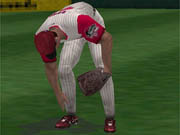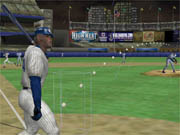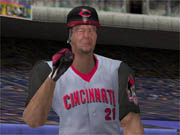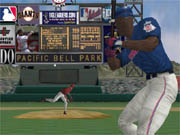High Heat Major League Baseball 2003 is an afterthought. Four years after the start of a brilliant run that led to the creation of what many would call the best arcade baseball series of all time, developer/publisher 3DO is now dealing in recycled goods. The carelessness that saw the company never properly patch last year's edition has carried over into a new game that in fact isn't new. High Heat 2003 is nearly a carbon copy of High Heat 2002 in the way it looks and plays, and its only serious addition to the series is an array of bugs. Although the fundamentals of the gameplay are still sound, so much of the total package is shoddy that the game isn't a good option for either newcomers to the series or returning customers looking to upgrade last year's model.

Speaking of last year's model, if you're familiar with the previous release in the High Heat series, you're already acquainted with the appearance of this year's edition. Everything is almost exactly the same as it was last year, when 3DO completed a long overdue face-lift. Unfortunately, even then the graphics were at least two years behind the gold standard set by EA Sports. Such an extremely dated look wouldn't be quite so bad if 3DO had at least ensured that we received good-looking 1999 visuals. But that isn't the case here. Certain aspects of the game can only be seen as second-rate, no matter how forgiving you are in regard to the calendar. There is still no collision detection, meaning that players have the uncanny ability to pass through one another (now that's how to avoid a tag). The animation is still clunky, particularly with the movement of fielders and catchers. Blocky buildings, blurry signs, and unbelievably pixelated scoreboards continue to make the stadiums seem unfinished. Player models are a touch above their surroundings, though a number of faces haven't been mapped properly. The features of many players are scrunched into a "lemon sucking" grimace that's either hideous or hilarious depending on your mood.
The game's other graphical elements are equally discouraging. 3DO has dropped the intro cinematic and performed a perfunctory renovation of the menu screens. Game functions are handled using the same old quasi-Windows interface, although a few things have been moved around, colors have been changed, and player models can now be seen on loading screens. Also new is a display bug that garbles player photos and the line art illustrations of ballparks in the menu screens (in-game player photos look fine). Experimenting with multiple driver versions for our GeForce3 Ti 500 did nothing to alleviate the issue, which appears to be widespread according to recent newsgroup and message board posts.

The audio is even more bug-riddled. Users have been reporting serious issues with Creative's popular Live! and Audigy lines. This was in evidence with our Live! Value, which exhibits pops and hisses from the right channel, occasional complete dropouts by the crowd, skipping that makes the national anthem sound like it's being fast-forwarded, and repeated lines from the commentators. Most annoying of all is a tendency for crowd noise to pan from one speaker to the other during games, a disorienting quirk that forced us to switch off this sound effect. We also shut off play-by-play man Dave O'Brien and new color commentator Chuck Valenches because of loud hissing that accompanied each line they spoke. This was done regretfully because both add more to the game this year in terms of situation-specific lines. Hearing O'Brien make comments like, "Let's see if he can hit his second jack in this AB," made the entire broadcast presentation seem more natural.

Underneath all this is some appealing gameplay. High Heat 2003 is a solid baseball experience. All the options are still available. You can play an exhibition game, set up full seasons or careers complete with a draft option, get into a playoff tournament, go online for a multiplayer contest, head out for some practice, and hit for distance in the home run derby. The pitcher-batter duel continues to be a mesmerizing re-creation of what happens in the real Major League each and every time a hurler takes to the mound. You need to take a strategic approach to each at bat no matter which side you're on. Batters have to be patient and pitchers have to constantly mix up pitch choice and location. Make a mistake and the AI will often kill you. Statistical results also continue to be pretty good. League and team leaders are typically right where they should be at the end of each season, although you'll see some odd variations and career years from the unlikeliest of candidates. As in past years, the overall stat generation is excellent for an arcade sports game, but not serious competition for management sims such as Diamond Mind Baseball and Out of the Park Baseball.
Things become even more accurate if you play with the tune file that configures on-field performance. 3DO has added a simulation level to the tune file setting that governs how much of the results are due to player stats and how much is due to the gamer's ability with a gamepad. A series of fine-tuning settings has also been added, addressing such items as human and computer hitting for average, fastball velocity, and runner speed. Experimenting with all the settings, new and old, should allow even the most critical gamer to balance play according to his or her own preferences. Most users will probably do some tinkering, if only to offset the exaggerated baserunning speed that the default tune file provides at higher difficulty levels.

Fine tuning is also evident in the gameplay mechanics. Pitchers now have access to more pitch types, including the cut fastball. The difficulty settings appear to have been tweaked, making "pro" easier and the next step, "all-star," significantly harder. The strike zone seems to have been moved up, something that nicely reduces those irritating strikeouts at the ankles. Pitchers are more aware of what's going on. They play to the particular situation at all times of the game, pitching around tough hitters with runners on and first open even early in games. Greater caution is exercised at all times by the computer pitching and defense, a nice contrast to past years, when you could almost guarantee that it would aggressively come at you no matter what. Computer trade logic has been bumped up. It's no longer possible to get superstars for a collection of motley rejects, at least.
While the heart of High Heat Major League Baseball 2003 is an impressive rendition of the national pastime, there are so many flaws in the surrounding layers that this achievement is very hard to appreciate. Many of these flaws have been with the series since its inception, though they have usually been offset by mitigating factors. It's hard to complain about subpar stadium art when you're taking part in nail-biting extra-inning contests complete with flawlessly realized pitcher-batter confrontations. This year, however, in the almost complete absence of anything new, the problems overwhelm the positives. Think of this game as an old baseball. It might still have a solid core, but the soggy yarn and torn cover make shagging flies with it something less than enjoyable.